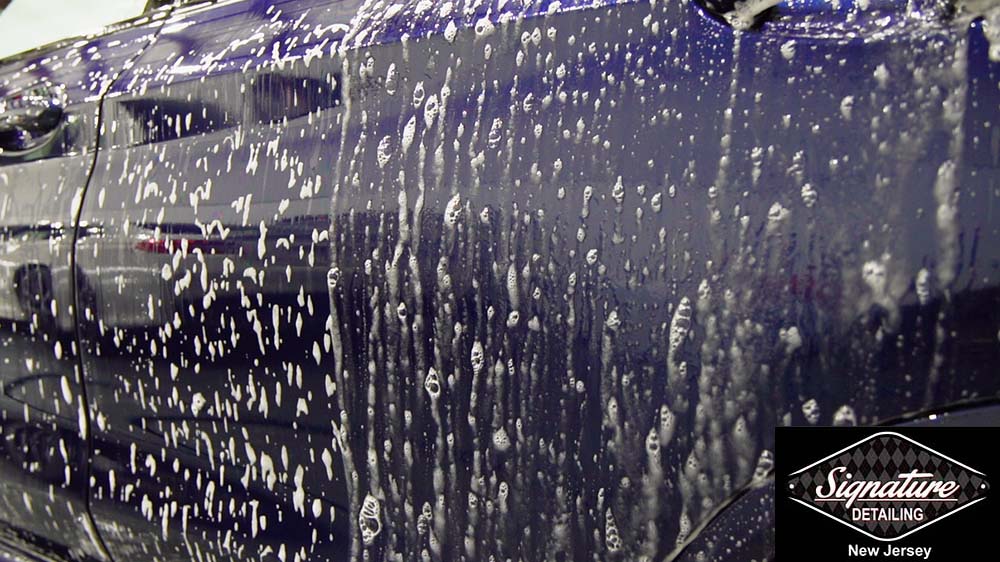
At Signature Detailing, in northern New Jersey, we primarily use the ‘Traditional Car Wash Method’ since we specialize in paint correction, ceramic coatings, and paint protection film (aka PPF or clear bra).
We use this method because New Jersey is subject to all four seasons of weather. We have wet falls, cold, snowy, icy winters, and wet springs. This means a lot of contamination finds its way into the many cracks & crevices of a vehicle and into the pores of vehicle paint systems. Therefore, we need to clean all surfaces, as deeply as possible, to prepare for advanced auto detailing services.
This article will examine if the ‘Traditional Car Wash Method’ is still the best for deep cleaning vehicle surfaces.
Defining the Elements of a Traditional Car Wash Method
The traditional car wash is the method you grew up with. You may have a memory of ‘helping’ either your father or grandfather with this type of car wash as a child.
The traditional car wash contains (more or less) the following elements:
- A bucket (or more, depending on your philosophy)
- A dedicated car wash shampoo
- A mitt, sponge, or other media to agitate (wash) the surface with during cleaning
- A hose, pressure nozzle, or pressure washer (depending on your budget or philosophy)
- Some sort of drying towel (microfiber drying towels are the ONLY way to go these days)
How to Perform a Traditional Car Wash
The traditional car wash method is what may seem ‘normal’ to most people.
Traditional Car Wash Steps:
- Use 1 Bucket or more ( depending on your philosophy) and add the appropriate amount of a dedicated Car Wash Shampoo (CarPro Reset), filling it 1/2 or 3/4 full with water
- Place the vehicle in the shade and make sure surfaces are cool to the touch
- Rinse the vehicle to remove all topical dirt and contamination (Best Practice: Use a Pressure Washer)
- Using a Foam Lance on a Pressure Washer (best practice), a foam gun, or even a foaming sprayer, add an even medium layer of soap to the surface so that is sticks and doesn’t immediately run off
- Use a Microfiber Mitt (DI Hybrid) or a sponge to manually agitate (wash) the vehicle surfaces
- After fully washing the vehicle, thoroughly rinse the entire vehicle so no soap remains
- After rinsing, immediately dry the vehicle with a large towel (The Gauntlet 20×30”) to remove all water
- as quick as possible
- Optional yet Optimal: Air Purge of Water from cracks & crevices
Why Does the Traditional Wash Clean So Deeply?
The following reasons demonstrate why the traditional wash method offers a more thorough and deep cleaning than all other methods.
The traditional car wash method with soap and agitation is:
- Capable of cleaning all vehicles, from light contamination to months or years of neglect
- Able to deep clean, or at least flush out, all vehicle cracks and hard to reach areas
- Quickly and safely remove the majority of dirt from surfaces without friction (with a pressure washer)
- Can penetrate deep down into pores of the paint with agitation for a thorough washing
Yes, the traditional car wash method requires more equipment and time to set up and to execute. However, the trade off versus the rinseless wash or the waterless wash, is the unparalleled depth of cleaning it provides.
Even vehicles that are maintained to a very high level with the other wash methods will periodically need a traditional wash to get the super squeaky-clean effect in all areas.
Closing Thoughts on the Traditional Car Wash Method
In closing, the traditional wash method, featuring soap, water and agitation, is the best solution to:
- Effectively clean medium, heavy, and extreme levels of dirt and contamination on neglected vehicles
- Deep cleaning all cracks and crevices of a vehicle via pressurized water
- Lift and remove bonded contamination from vehicle surfaces
- Most effectively remove contamination from within the pores of the paint system
- Prepare vehicles for advanced detailing services such as: paint correction, ceramic coatings, and paint protection film (aka PPF or clear bra).
Sometimes the old ways are the best.
In this case, we must agree.
Because all around, no other wash method can compete with the traditional soap and water wash method. Its pressurized water, manual agitation of surfaces, and forced drying of cracks and crevices deliver the deepest and most thorough cleaning of all vehicle wash methods.
So, while the Traditional Car Wash reigns supreme, as king of the deep clean, does that mean it’s ‘standard’ procedure, as used over the last decade, is the most efficient or safest?
Stay tuned for our take on that.
